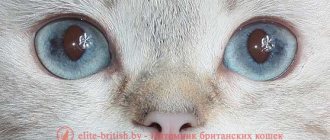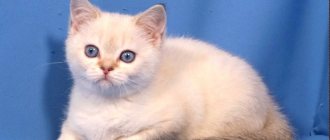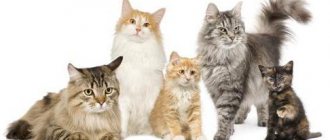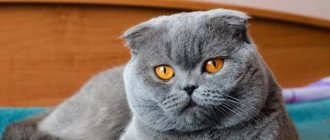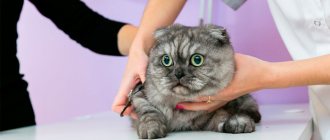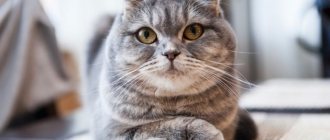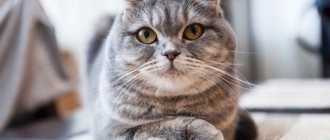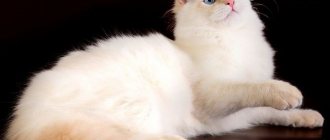Origin story
The only significant difference between Scottish Straight cats and Scottish Fold cats is in the ears.
They are not curved, but straight - that’s the whole difference. These cats appeared in the 60s of the last century on an ordinary Scottish farm, and initially the cats’ ears were folded. Breeders, having started breeding a new breed, quickly found out: in litters, both kittens with curled ears and normal ones are usually born, and in addition, the gene responsible for the lop-eared gene negatively affects the health of animals. The cats' bones thickened, early osteochondrodysplasia appeared, and they died early. Through trial and error, it became clear: the best option for crossing is a cat with straight ears and a fold-eared cat.
The Scottish Straight breed was officially registered in 2004 and immediately became extremely popular.
A kitten not for breeding costs about 5,000 rubles (without documents) and 10,000 rubles with documents. Show-class specimens will cost 18-25 thousand rubles.
History of the breed
A new breed of Highland Straight, the Scottish Longhaired Straight cat, was recognized in the 1970s.
It was obtained as a result of breeding work.
Persian cats were crossed with British cats to diversify the colors.
Then the British began to be crossed with Scottish Folds to increase the number of fold-eared individuals.
As a result, an interesting long-haired and straight-eared Highland Straight breed appeared.
Wonderful smoky color
At the moment, this variety is recognized by most associations.
But due to the fact that this is a rare breed, it can not be seen at all exhibitions.
Interesting! The word "highland" comes from the name of the Scottish highlands.
The Scottish Highland Straight is a rare and exquisite breed.
Although it was developed relatively recently, it has its own characteristics.
- Longhaired Scottish cats, photos of which are presented in the article, trace their origins to a wild cat that lived in the Scottish mountains back in the 18th century.
- The Highland Straight was crossed with the British and Persians. This relationship explains their beautiful coat and wide range of colors.
- Highland Straights are crossed with Fold cats/females, so different kittens are produced in the same litter.
- The Highland Fold is a rare breed. By getting such a pet, the owner essentially becomes a collector of rare specimens.
Standards
The weight of a Scottish Straight individual is 3-3.5 kg, rarely more.
| Standard | Description |
| Head | The shape of the skull is round, with convex cheeks and forehead. The cheekbones are clearly defined (more so in cats than in cats), the chin is strong. The whisker pads are oval and plump. The nose is short, with a wide bridge and no noticeable stop. |
| Eyes | Large, widely spaced. The iris can be any color. |
| Ears | Large, wide at the base and with rounded tips. The outside is abundantly pubescent, the inside is less, but lush panicles, hard and long, grow on the skin. |
| Torso | Muscular, long, large, but with soft smooth lines. The neck is muscular and short. |
| Limbs | Long, strong, with oval and elastic legs. |
| Tail | Long, dense, reaching the shoulder blades in length. |
| Wool | The coat is thick, dense, and plush to the touch. It can be either short or medium length. Undercoat is present. |
Serious defects are considered:
- turned out toes;
- cryptorchidism;
- creases on the tail;
- short tail;
- small eyes;
- explicit “stop”;
- flat forehead;
- too wide ears.
Marble on gold
Exquisite and rich color, quite rare among straight cats. Golden wool has clear dark stripes in the form of various black shapes, zigzags, and stripes. Animals with silver and gold marbled colors have the letter “M” on their foreheads, and their eyes are predominantly yellow and copper.
A kitten that has such a luxurious color has a freedom-loving character and does not tolerate coercion. As a rule, owners try to give their pets sophisticated nicknames.
Calico (patchwork turtle)
Only Scottish Straight cats can have this color. The main white color of the fur coat is effectively combined with two more colors: red, black, cream. They say that a three-colored “child”, which must have a corresponding nickname, brings happiness.
It’s hard to say whether this is true or not, but it’s a fact that no one can remain indifferent to such a lovely little girl. Tortoiseshell cats are in high demand among breeders, because later they can produce kittens of a wide variety of colors.
Weight table by month
The Scottish Straight weight gain graph is clearly demonstrated in the table by month.
| Age | Female (weight in kilograms) | Male |
| 1 month | 0.3-0.65 g | 0.45-0.75 g |
| 2 | 0.45-0.8 g | 0.8-1.6 |
| 3 | 1.25-1.7 | 1.3-2.4 |
| 4 | 1.7-2.35 | 2.1-3.8 |
| 5 | 2.25-3.1 | 2.45-4.2 |
| 6 | 2.3-3.5 | 3.1-5.5 |
| 8 | 2.9-4.3 | 3.4-6 |
| 10 | 3.1-4.6 | 4.2-7.2 |
| 1 year | 3.2-5.3 | 4.6-7.4 |
| 2 and older | 3.4-5.6 | 5.3-8.2 |
Colors
Basic shades (solid):
- Black (a little white wool is allowed, but brown or red is considered a defect).
- White (with amber or copper eyes, or multi-colored eyes).
- Gray (without other color inclusions or patterns).
- Red (patterns on the paws and forehead are allowed).
- Chocolate (plain).
- Lavender (lilac, with a light brown nose and copper-colored eyes).
- Blue (blue: kittens may have patterns on their fur and copper eyes).
- Cream (possible patterns on tail and paws).
- Cinnamon (paw pads and nose - pale pink).
- Faun (eyes are bright, rich copper or amber, nose and paw pads are beige-pink).
- Bicolor colors - an admixture of white on the limbs, belly, chest or face. These are harlequin, van, ticked, shaded, tabby.
In the photo there are Scottish Straight cats of popular colors: black, white, blue
Rare colors: chinchilla, tabby, smoky, color point, calico, tortoiseshell (classic).
When choosing a pet for home keeping, color is not important, but in exhibition activities it is of no small importance. The CFA, for example, does not recognize chocolate, lilac, point, or all colors with white spots.
Black
Black straights are unusually elegant and graceful. They can become a true decoration of your home. A shiny, pitch-black fur coat looks incredibly impressive. The aristocratic charcoal color of their coat makes these animals look like a shadow moving unnoticed around the house.
INTERESTING TO KNOW: Kurilian Bobtail: how to get a miniature lynx at home
The deep, attentive gaze of shining amber eyes is always gentle for the owner, but for strangers it can serve as a warning signal - Scottish Straight black smoke does not like strangers. Scots with this type of color behave with dignity and do not allow unnecessary pranks.
Character and behavior
Looking at the imposing and massive Scottish Straights, you might think that they are lazy and do not see beyond their food bowl. Not at all! Of course, among cats of this breed (as well as among individuals of other breeds) there are many phlegmatic animals, but not all have such a specific character. Scottish Straights are reasonable and careful, they look closely and think for a long time before taking on any business, but this does not mean at all that they are stupid or slow.
Scottish Straights can run as fast as their feline counterparts and love new toys and running around. They just need a little more rest and quiet. They are not hermits or beeches: Scottish Straights love to be the center of attention, but they also easily tolerate loneliness.
The peak of playfulness occurs in the first couple of years of their life; for the rest of the years, cats prefer a leisurely existence in comfort and coziness, next to their favorite representatives of the human race.
They are careful, restrained in expressing feelings, but affectionate and very patient. These are the same cats that you can have in a family with small children. Scottish will never allow himself to scratch a child or scare him with a loud hiss. If the cat is “pushed”, he will silently run away and hide, but will not take revenge. They are not vindictive or vindictive, and do not suffer from mood swings, but they can be very persistent and even obsessive. If they really want something, they will follow you on your heels and scream until victory.
Name the cat who always wanted to live together
BasilioLeopold
They respond well to learning basic skills - going to their litter box (How to train a kitten to use the litter box?), eating at certain hours, not stealing from the table - but training is not for them. They get along well with other cats and even dogs, but they do not like small animals.
A change of environment is difficult for them, as is moving. They are afraid of heights, loud sounds and do not like water.
Reviews about the Scottish Straight cat breed
- Alina.
The kitten quickly adapts and easily gets used to new places. Quite tame, he allows himself to be hugged, stroked and kissed, but if he gets wild, it is almost impossible to stop him. Loves to sit in your arms. After castration, his character did not change; he remained eccentric and sometimes harmful. A very inquisitive animal. He eats everything, he got used to the tray very quickly. Here are some photos of my Scottish Straight cat Vasily.
- Katerina.
The cat quickly got used to all the household members, but most of all she became attached to me, she also sleeps with me. In addition, she quickly learned to go to the litter box. She is affectionate and gentle by nature, but sometimes she can be very lazy. Doesn't like strangers in the house. In the photo, my Scottish Straight cat is two years old.
Care instructions
Scottish straights are extremely clean. They carefully monitor the appearance of their coat and the length of their claws, so these points require minimal attention from you.
If the animal is very dirty, it should be bathed using cat shampoo, and during shedding, it should be combed not once a week, as usual, but 2-3 times. Buy a stable scratching post and place it in a visible place - the cat will quickly adapt to it.
But cats in captivity do not know how to clean their ears and teeth. So this is your task. The ears are wiped weekly with a cotton swab dipped in boiled water or chlorhexidine, and the teeth are brushed every 10-14 days using a special paste and a small toothbrush with soft bristles.
Expert opinion
Dusheba Vera Ivanovna
In 2010, she graduated from the Moscow State Academy of Veterinary Medicine named after K.I. Scriabin with honors, specializing in veterinary medicine. I regularly attend veterinary conferences, congresses, and webinars.
You cannot use human cosmetics and hygiene products, even children’s! The components included in your shower gel or children's toothpaste can cause disturbances in the gastrointestinal tract and even poisoning.
Care and maintenance
Procedures necessary to maintain the health and comfortable living of a Highland Straight family:
| Bathing | Combing | Going to the doctor | Eye treatment and ear cleaning | Nail cutting |
| Once a year or when soiled, after a walk, immediately before the exhibition | Once a week, every day during shedding period | At the first signs of illness and on schedule (check with your veterinarian for vaccination times) | Once a week | Use small nail scissors once a week, being careful not to touch the skin around the claw. |
Caring for a Scottish Straight cat with long hair is different from caring for short-haired cats. First of all, the size and thickness of the coat without proper combing will become a problem for everyone living in the house. The procedure is performed with a special comb; during the molting period, the need for combing the fur increases.
You may be allergic to Scottish fur, symptoms of an allergic reaction to cat hair:
- redness of the eyes
- edema
- itching
If symptoms appear, you should consult a doctor and get tested.
Straight-eared Scots can be on a natural and mixed diet, as well as receive exclusively factory-made food. Some animals eat natural food for up to 6 months, sometimes commercial feed. After six months of life, pets are completely transferred to the dry variety.
Veterinarians advise to refrain from purchasing cheap food. Cats usually quickly get used to them and love them because of the presence of flavor enhancers. But this is detrimental to the health of pets and negatively affects the appearance of the crumbs’ fur. And in the future, difficulties are observed when switching to more expensive, but high-quality food.
To preserve furniture and walls, cats must be trained to use a scratching post. If the baby does not get used to the device and scratches the surface in the house, it means that the animal was taken away from the cat too early and was not raised.
Rules that must be followed by family members after the arrival of a purebred pet at home:
- You cannot leave the balcony door and window open; a curious animal may fall out of the apartment. It happens that if a cat falls from the 10th floor, it will only get away with fright. But most often, flying even from the third floor will cause injuries and bruises to the pet that are incompatible with life.
- Do not leave the window and door in the microclimate. The baby can get stuck in a narrow gap and die.
- Do not allow a purebred cat to roam freely. Often, owners find a cat left unattended on the street, torn apart by dogs.
- Care must be taken to ensure that the animal does not swallow a foreign object. Due to the structure of the tongue, the cat cannot spit out the thread or rain (Christmas tree decoration), the eaten bag will cause the cat to appear on the surgical table. Since, by pulling the insides of the intestines, the rope creates conditions for food obstruction, and the baby dies if medical assistance is not provided in time.
This fluffy handsome guy is not only a cute toy, it is responsibility and care.
Highland Straight photo
Catering
The issue of feeding should be approached with all seriousness: you cannot feed a living creature with just anything.
Food that is fatty, over-salted, with artificial preservatives and dyes in its composition will not bring any benefit to your pet, but it can “add” the stomach, liver, and other organs literally once or twice. And not all food from your table is suitable for an animal, even if it is good for you.
Natural products
Digestion is significantly different between humans and cats. The first thing a cat needs is calcium, phosphorus and taurine.
- And these substances can only be obtained from raw meat, lean and fresh: beef, chicken, rabbit, turkey, veal, lamb. During heat treatment, calcium transforms into a form that is practically not absorbed by the body, and taurine completely disintegrates. Meat components (muscle meat, offal, meat bones) should make up 90% of the daily diet.
- 5-10% are vegetables. Pumpkin, carrots, asparagus, zucchini, green beans, cauliflower, broccoli, greens (parsley, dill): vegetables are boiled or stewed and mixed with cereals. Cats rarely eat raw food.
- Rice, millet, oatmeal, buckwheat, semolina and pearl barley porridge are allowed. You can feed your cat with them every other day. Porridge is cooked in plain water without adding sugar, salt or seasonings.
- Chicken and quail eggs can be given no more than 2 times a week. Quails are boiled and fed whole; chicken ones are given only the yolk.
- Fish - flounder, hake, trout, salmon, tuna, navaga, saury, mackerel, ivashi, burbot, tench, chum salmon, carp - contains easily digestible protein, omega-3 and omega-6, and vitamins. But there is practically no calcium there, which causes problems with the musculoskeletal system in Scottish Straight cats. Therefore, fish can be given in small pieces along with meat and no more than once a week. Lack of fish will not negatively affect your cat's health if you add fish oil to the food.
- Low-fat fermented milk products - sour cream, yogurt, fermented baked milk, cream, cottage cheese, unsalted hard cheese - can be given every day, preferably in the afternoon.
- Vitamin-mineral complex, dry yeast in tablets, spirulina, kelp, sprouted alfalfa are very useful and should also be included in the diet.
Potatoes, legumes, cocoa-containing products, juices, alcohol, citrus fruits, bones, flour products and baked goods are prohibited!
Clean water at a comfortable temperature should always be available! You cannot give your animal water directly from the tap: tap water contains bleach and other components hazardous to the cat’s health.
Recommended food
From industrial feeds, choose only super-premium and holistic feeds. Go Natural, Savarra, Wellness CORE - these foods are recommended by both breeders and veterinarians.
Below are recommended super-premium foods. Links with the names of the food are clickable, on them you can, within our website, get acquainted with the descriptions of the food and read reviews from owners of cats of the Scottish Straight breed.
| Holistic | Super premium | Super premium |
| Wildcat | Golosi | Karmy |
Diseases
The most common problems are:
- Discharge from the eyes. This is not necessarily a sign of an illness: it is often due to the specific structure of the skull and narrow tear ducts. If the discharge is clear or brown and odorless, there is nothing to worry about. But an admixture of yellow or red pus is a signal of a problem.
- Otitis, ear mites, fungus. If your pet constantly shakes its head and seems to be trying to get something out of its ear, take it to the vet. Maybe something got inside, maybe you scratched the delicate skin while cleaning, or maybe it’s due to the onset of a disease.
- Joint problems (eg osteochondrodysplasia). Over time, the bones become deformed, which is why the animal begins to experience difficulties when walking: it cannot fully straighten its paws, and it is difficult for it to jump.
- Urolithiasis disease. Castrated males are more likely to suffer from this disease. There may be several reasons: lack of vitamins, hormonal imbalance, severe cold, infection, poor diet. The animal begins to run around frequently, stops eating, becomes lethargic, licks itself frequently, and blood is visible in the urine.
- Excess body weight. Scottish Straight cats are prone to obesity, so their diet should be monitored especially carefully.
Expert opinion
Dusheba Vera Ivanovna
In 2010, she graduated from the Moscow State Academy of Veterinary Medicine named after K.I. Scriabin with honors, specializing in veterinary medicine. I regularly attend veterinary conferences, congresses, and webinars.
Whether or not to vaccinate your pet is up to each owner to decide for himself. But remember: you can bring pathogens into the house on your hands, clothes, and shoes. In this case, even thorough washing and disinfection of the premises may not save the animal from infection. Distemper, panleukopenia, calcivirosis, rabies are mortally dangerous and without vaccinations your beloved creature will face a painful death. In addition, without vaccinations you will not be able to take your cat abroad.

